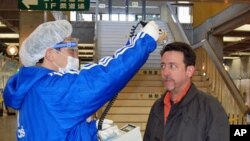Modern Geiger counters don't click. As is the case with so many other devices, they have gone digital. At least that is true for the high-tech Japanese Geiger counters here. But they still measure radiation exposure in the quaint-sounding "clicks per minute."
After spending nearly all of the past six days in the "hot zone" of Fukushima Prefecture, it seemed prudent, while reporting from a radiation screening checkpoint, to see how much clicking my own body would register.
Arriving at the Koriyama Municipal Gymnasium was akin to walking on to the set of a science-fiction movie. Men clad head to toe in white anti-contamination suits calmly guided visitors through the gauntlet. Other "space men" unloaded boxes full of white masks.
Japanese, young and old, expressed no emotion as a mysterious device rendered their radioactive fate.
When my turn came the needle began to jump as the man in the space suit scanned my torso. I knew not to become immediately alarmed. After all, with the jump in background radiation levels in the past few days in the prefecture, it was not surprising that I had absorbed some extra radiation.
I had done an online cram course in radiation to conclude that even if I had been quite close to the crippled nuclear facility (and I was at least 30 kilometers away at all times), I was unlikely to have picked up more radiation than I would absorb on a trans-Pacific flight - or, at the very worst, a chest X-ray.
When the Geiger counter descended to my feet I looked at the meter and my heart jumped. The reading had pinned the needle.
I noticed a subtle look of surprise in the technician's eyes - perhaps he was thinking, "I've got a live one!" ( this one is worth special attention ) He switched the meter to a higher scale and intoned that perhaps I should wash my footwear.
"What is the reading?" I asked in Japanese, with the same nervous voice one might use seeking the results of a biopsy. He replied, "3,000 cpm [clicks per minute]."
CPM is a comparatively crude measurement to determine radiation exposure, calculating the number of atoms in a certain quantity of radioactive material that are detected to have decayed in one minute.
It was important to put things in journalistic perspective. So I asked, what was the typical reading in Koriyama for a test subject prior to the radiation leakage from any of the six troubled reactors at the Fukushima-1 plant?
The technician replied that it would have been 300 to 600 cpm. He also said it was likely that my boots had picked up the radiation from material falling from the sky in the rain and snow during the past couple of days. By comparison, the reading on my torso peaked around 1,500 cpm.
I was assured that the current readings, even on my 20-year-old boots, were nothing alarming.
As I moved toward the exit, a pair of white-suited men handed me a yellow card. That's not a good sign in football (soccer). However, I was assured that the paper certifying I had undergone radiation screening was an "all-clear" document. It would allow me entry to one of the shelters now home to more than 200,000 evacuees from the core of the Fukushima hot zone. If I had needed medical attention, based on my scan, I would have been given a green card and presumably escorted to a decontamination center.
So far, authorities say, only a handful of people apart from nuclear-plant workers have generated more than brief concern, and all were told merely to wash their hands and face.
That situation could change drastically if any of the reactor cores or spent fuel rods go critical, something that government sources here acknowledge is no longer an impossibility.
Images of the disaster in Japan

















